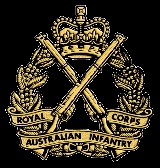
Royal Australian Infantry Corps
Overview
Australian Army
The Australian Army is Australia's military land force. It is part of the Australian Defence Force along with the Royal Australian Navy and the Royal Australian Air Force. While the Chief of Defence commands the Australian Defence Force , the Army is commanded by the Chief of Army...
. It was established on 14 December 1948, with its Royal Corps status being conferred by His Majesty King George VI. At her coronation in 1953, Queen Elizabeth II became Colonel-in-Chief of the corps. Major components of the RA Inf include the various battalions of the Royal Australian Regiment
Royal Australian Regiment
The Royal Australian Regiment is the parent regiment for regular infantry battalions of the Australian Army and is the senior infantry regiment of the Royal Australian Infantry Corps...
and the six state-based Reserve
Australian Army Reserve
The Australian Army Reserve is a collective name given to the reserve units of the Australian Army. Since the Federation of Australia in 1901, the reserve military force has been known by many names, including the Citizens Forces, the Citizen Military Forces, the Militia and, unofficially, the...
infantry regiments, such as the Royal New South Wales Regiment
Royal New South Wales Regiment
The Royal New South Wales Regiment is a reserve infantry regiment of the Australian Army based in the state of New South Wales. The regiment consists of four battalions:-Organisation:*1st/19th Battalion*2nd/17th Battalion*4th/3rd Battalion...
.

